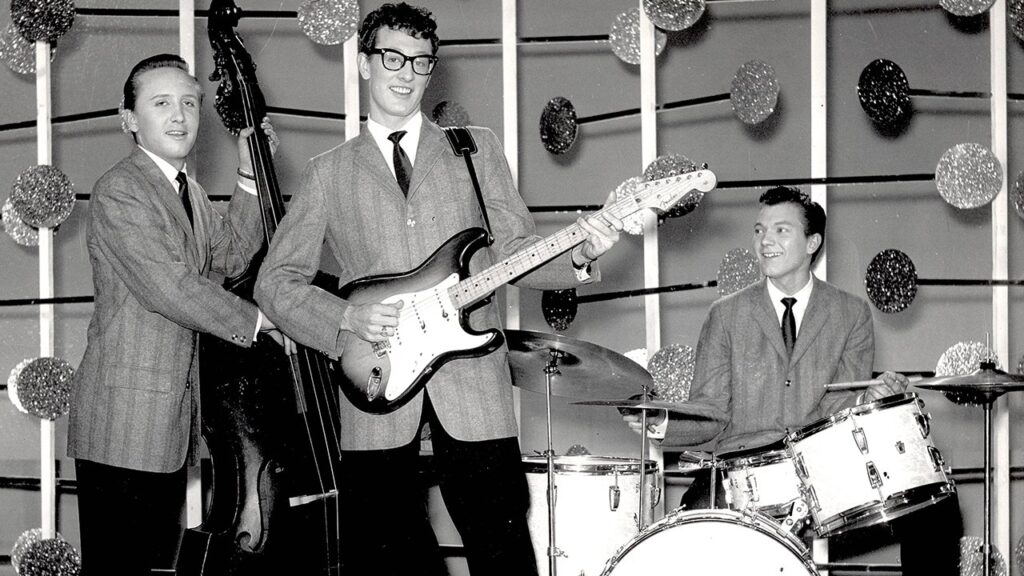Buddy Holly, born Charles Hardin Holley on September 7, 1936, in Lubbock, Texas, remains a seminal figure in the landscape of American rock and roll music. Holly’s surname underwent an inadvertent alteration, transitioning from “Holley” to “Holly,” due to a clerical error in a contract he signed early in his career. This change, however, did not diminish his impact on the music industry, as he is celebrated today as one of the pioneers of the genre, marking the beginning of an illustrious yet tragically short life.
From a young age, Holly displayed extraordinary musical talent, learning to play the piano and fiddle as a child. His older brothers contributed to his education by teaching him the fundamentals of guitar. According to a source from Biography.com, his parents nurtured his burgeoning musical interests, supporting him in his artistic endeavors. The sounds of rhythm and blues, which permeated the airwaves in his youth, captivated him, influencing his artistic trajectory. By the age of sixteen, after immersing himself in various musical styles, including country, bluegrass, and gospel, Holly developed a passion for the vibrant rhythm and blues that was sweeping the nation.
Elvis Presley proved to be a monumental influence on Holly during the mid-1950s. Enchanted by Presley’s dynamic stage presence and infectious musical style, Holly committed himself to rock and roll. In late 1955, he acquired a Fender Stratocaster electric guitar, which became integral to his musical identity. His innovative style, characterized by distinctive major chords, generated a sound that would resonate through hits like “Peggy Sue.” This era marked a transformative period in Holly’s life, as he transitioned from local performances to national recognition.
Holly’s career took a significant leap when he had the opportunity to perform as an opening act for Bill Haley and his Comets during a rock and roll concert in Lubbock. This performance was a pivotal moment, ultimately leading to a contract with Decca Records. However, his early endeavors as a solo artist faced challenges, as initial success proved elusive. It was only after officially adopting the name “Buddy Holly” in early 1956 that his career began to gain momentum.
In collaboration with his band, the Crickets, Holly recorded a series of influential tracks at Norman Petty’s studios in Clovis, New Mexico. Among their notable recordings was the hit “That’ll Be the Day,” which skyrocketed to success. By March 1958, Holly and the Crickets embarked on a tour of the United Kingdom, further cementing their status in the rock and roll scene. Shortly after, Holly entered a new chapter of his life, marrying Maria Elena Santiago on August 15, 1958. However, in early 1959, the artist parted ways with the Crickets to pursue a solo career.
Tragically, that same year, on February 3, Buddy Holly’s life was cut short when he, alongside fellow musicians Ritchie Valens and J.P. “The Big Bopper” Richardson, perished in a plane crash. This devastating event occurred shortly after their performance at the Surf Ballroom in Clear Lake, Iowa. A mechanical failure with their tour bus led Holly to charter a plane to expedite their travels. Compounding this tragedy, Richardson, suffering from the flu, convinced Holly’s band member Waylon Jennings to relinquish his seat on the flight. Ritchie Valens won a coin toss for another seat, resulting in the fateful journey that would claim their lives.
At merely 22 years old, Holly’s death represented a significant loss to the music world. Investigations later attributed the crash to a combination of adverse weather conditions and pilot error. Holly’s legacy continues to thrive, as evidenced by the iconic headstone that honors him, featuring the correct spelling of his surname and a carving of his beloved guitar. The Buddy Holly Hall of Performing Arts and Sciences, which opened in Lubbock in January 2021, stands as a testament to his lasting influence.
Renowned singer Don McLean immortalized Holly in his 1972 hit “American Pie,” which poignantly referred to February 3, 1959, as “the day the music died.” Holly’s music endured through the decades, with unissued recordings and compilations released throughout the 1960s. His iconic horn-rimmed glasses have become emblematic of his persona, ensuring that Charles Hardin Holley’s legacy as Buddy Holly continues to resonate with artists and fans alike.



